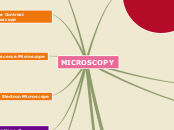Microscopy
electron microscope
Electron cryotomography
provides extremely high resolution images of
-cytoskeletal elemetns
-magnetosomes
-inclusion bodies
-flagellar motors
-viral structures
images are recorded from many different directions to create 3D structure
rapid freezing technique provides way to preserve native state of structures examined in vacuum
Transmission electron microscope (TEM)
principal uses: to examine viruses or then internal ultrastructure in thin sections of cell
resolving power- 2.5 nm
magnnification- 10 000X to 100 000X
image produce- two dimensional
structures smaller than 0.2µm
Scanning electron microscope (SEM)
principle used: to study the surface features of cells and viruses
resolving power- 20 nm
magnification - 100X to 10 000X
produces a realistic 3D image of specimen's surface features
strcutures smaller than 0.2µm
resolving power 100 times than light microscope
wavelength= 0.01A
employs a beam of electron in place of light wave to produce the magnified image
preparation of specimens for light microscopy
smears
staining
special staining
flagella staining
Mordant and Carbolfuchsin applied to increase thickness of flagella
endospore staining
used for identifiying bacteria that can produce tough, dormant spores
negative staining
visualize capsules surrounding bacteria
preparing colourless bacteria against coloured background
differential staining
acid-fast staining
useful for genus Mycobacterium
very intensive decolourizer
gram staining
gram negative
gram positive
simple staining
basic dyes frequently used
acidic dyes frequently used
revels basic cell shaped and arrangements
single staining agent is used
microorganism is killed and firmly attached to microscope slide
chemical fixing
heat fixing
preserved internal and external structures and fixed them in position
Preparing smears
fixation
air dry completely
thin suspension of cells placed on glass, no cover slip needed
wet mount
demonstrating motility or structure od microorganisms
Introduction
Microscope is an instrument to observe microorganisms
Electron microscope
Light microscopes
Cells are microscopic
Unit of measurement
micrometers, nanometers and angstroms
1 meter = 10^9 nanometer
1 meter = 10^6 micrometer
metric system
Light microscope
compound microscope
image formed by action of ≥2 lenses
Total magnification = multiply the objective lens magnification by the ocular lens magnification
ocular lenses magnification
-10X
objective lenses magnification
-10X
-40X
-100X
-oil-immersion lens
ocular lenses- magnified the specimens
objective lenses- magnifies the specimens
condenser- to direct the light through the specimen
illuminator - source of light
uses visible light as source of illumination
( 400nm to 700nm)
confocal microscope
numerous applications including study of biofilms
confocal scanning laser microscopy ( CLSM) creates sharp, composite 3D image of specimens by using laser beam, aperture to eliminate stray light, and computer interface
fluorescence microscope
has applications in medical microbiology and microbial ecology studies
shows a bright image of the object resulting from the fluorescent light emitted by the specimen
fluorescence
microorganism appear as bright object against dark background
fluorochrome- labeled probes, such as antibodies, or fluorochrome dyes tag specific cell constituents for identification of unknown pathogens
cell contains natural fluorescent substances (eg. chorophyll ) or has been treated with fluorescent dye( eg. auramineO)
spme chemical substances absorbs the energy of ultraviolet waves and emit it as visible waves of greater length- fluorescent
essential tool in microbiology
specimens usually stained with flurochromes
exposes specimen to ultraviolet, violet or blue light
Ultraviolet
image are made visible by recording on a photographic emulsion, or by display on a television screen after pickup by an ultraviolet- sensitive television camera tube
Ultraviolet radiations are invisible
has a shorter wavelength( 180-400nm)
permits greater resolution than conventional light microscope
phase-contrast microscope
stain is not necessary, view internal structure s of living organisms
excellent way to observe living cells
some light rays from hollow cone of light passing through unstained cell slowed/ out of phase ( dark against bright background )
converts difference in refractive index/ cell density into detected variations in light intensity
dark-filed microscope
Used to observe living, unstained preparations
identify bacteria such as Treponema pallidum
internal structures in eukaryotic microorganisms
Produces a bright image of the object against a dark background
image is formed by light reflected or refracted by specimen
bright- field microscope
total magnification = product of the magnifications of the ocular lenses and the objectives lenses
use in lab, requires stain
produce a dark image against a brighter background
Magnification and resolution
Resolution/ Resolving power- ability to distinguish two adjacent point
highest resolution in compound light microscope
- 0.2µm
Magnification- size of image or point
Goals
render the details visible to the human eye or camera
Separate details in the image
Produce a magnified image of the specimen









